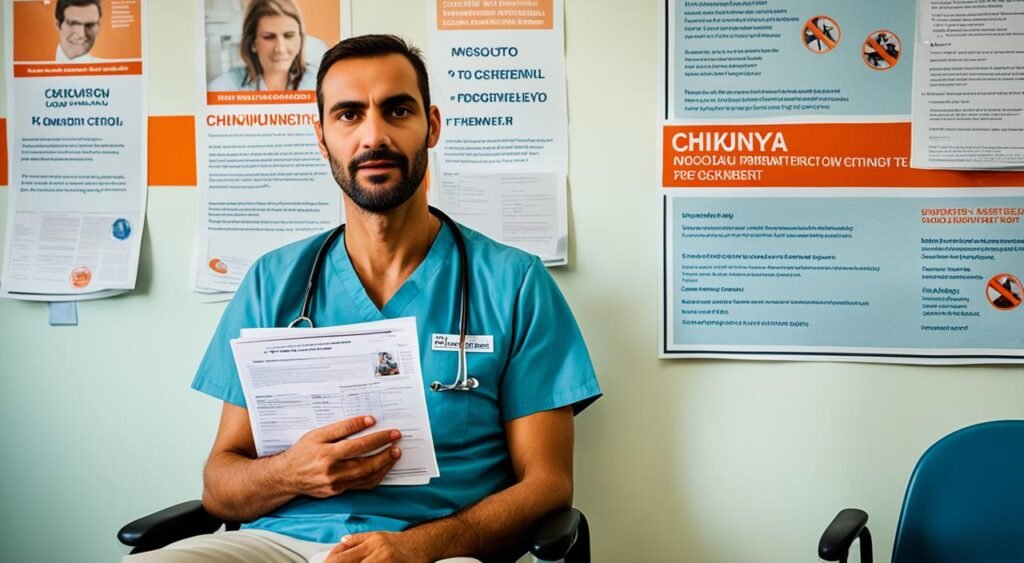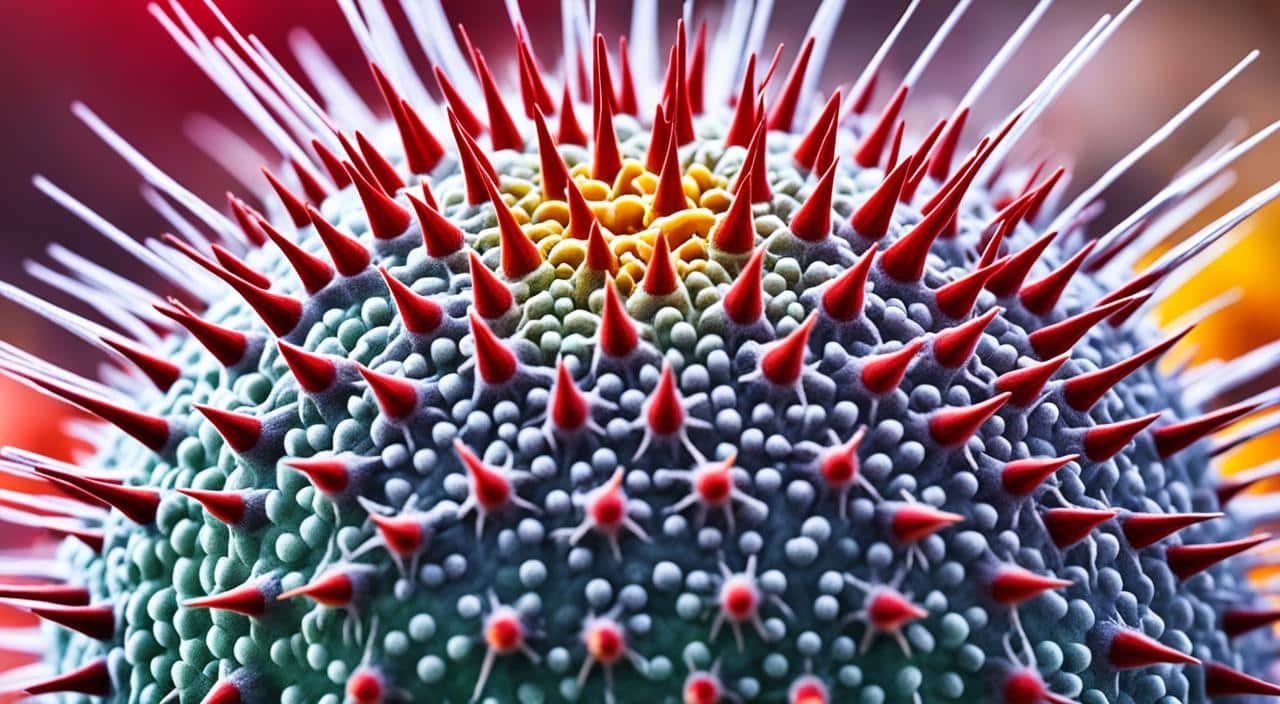Chikungunya is a viral disease spread by infected mosquitoes, mainly Aedes aegypti and Aedes albopictus types. It starts with fever and severe joint pain. This pain can make it hard to move and may last weeks or months. The top way to avoid chikungunya is by preventing mosquito bites. Also, consider vaccination before you travel to areas where the virus is common.
Key Takeaways
- Chikungunya is a mosquito-borne viral disease that can cause severe joint pain and fever.
- The primary prevention methods include using insect repellents, wearing protective clothing, and treating clothing and gear with permethrin.
- Maintaining a mosquito-free environment in your home and during travel is also crucial.
- Seeking prompt medical attention if you develop symptoms after traveling to affected areas is important.
- Getting vaccinated before travel is recommended in certain cases, if the vaccine is available and approved for your destination.
Also Read : What Are The Health Benefits Of Cycling Regularly?
Understanding Chikungunya
Chikungunya is a viral disease that comes from an RNA virus. It falls into a group of viruses known as alphaviruses. You mostly get it from the bite of infected mosquitoes, called Aedes. These mosquitoes can give you dengue and Zika too. Knowing about chikungunya is key to stopping it and helping those who get sick.
Also Read : Exploring PHD Scholarship Opportunities In 2024
What is Chikungunya?
Chikungunya showed up first in Tanzania in 1952. Its name comes from a word in the Kimakonde language, which means “to become contorted.” This describes how people look when severe joint pain hits them.
Symptoms and Transmission
After you’re infected, symptoms show up in about 3 to 7 days. They often include a high fever, bad joint pain, headaches, and tiredness. You might also get a rash and swollen joints. The joint pain can be really bad and last for a long time.
It’s more dangerous for the very young, the old, and those with health issues. Chikungunya isn’t often deadly, but it can lead to death in those high-risk groups.
The chikungunya virus mainly moves through certain mosquito bites. These mosquitoes are found in warm places all over the earth. This makes chikungunya a big problem for everyone, everywhere.
Also Read : Exploring Global PhD Scholarship Opportunities For Graduated Students
“Chikungunya is a viral disease that can cause severe joint pain, fever, and rash. It is transmitted by infected mosquitoes and can be a serious public health threat in affected areas.”
Chikungunya Outbreaks and Distribution

In the last few decades, chikungunya has become a major health issue worldwide. It has spread to over 110 countries, affecting Africa, Asia, Europe, and the Americas. The virus, discovered in Tanzania in 1952, keeps evolving and moving to new places.
The chikungunya virus has become more easily spread by the Aedes albopictus mosquito, known as the “Asian tiger mosquito.” This change lets the virus survive in areas where these mosquitoes live. These regions are often tropical or subtropical.
Also Read : Find Your Future: MBA Scholarship Programs In US Institutions
The World Health Organization (WHO) notes chikungunya outbreaks in Africa, Southeast Asia, the Indian subcontinent, the Pacific region, and the Americas. The last big outbreak started in the Americas in 2013. It spread to more than 45 countries and territories.
“The increasing frequency and geographic spread of chikungunya outbreaks pose a significant threat to global health, underscoring the need for heightened surveillance, effective prevention strategies, and a coordinated international response.”
As chikungunya reaches new areas, it’s vital to learn its distribution patterns and spread causes. This knowledge is key to making strategies to prevent and control the virus. Ongoing studies and watchful eyes are crucial in tackling this global health concern.
Also Read : Best MBA Scholarship Programs For Canadian Graduates
Protecting Yourself from Mosquito Bites

It’s important to avoid mosquito bites to stay safe from chikungunya. This viral disease spreads through mosquito bites. To stay safe, use these tips:
Use Insect Repellents
Use insect repellents that the EPA approves. They should have DEET, picaridin, IR3535, oil of lemon eucalyptus, or 2-undecanone. Always follow the product’s instructions, and put it on after sunscreen for the best results.
Wear Protective Clothing
Wear long-sleeved shirts, long pants, and socks to cover your skin. This creates a layer between you and mosquitoes. It helps lower the chance of getting bitten.
Treat Clothing and Gear with Permethrin
Spray permethrin on your clothes, shoes, and gear. It adds to your protection by killing or repelling mosquitoes. Even after washing things, they can still help keep mosquitoes away. This is key for mosquito bite prevention and chikungunya prevention.
Use these steps every day to lower your risk of mosquito bites. This way, you can reduce the chance of getting chikungunya. Be aware and do what you can to stay healthy while outside.
“Protecting yourself from mosquito bites is the first line of defense against chikungunya.”
Chikungunya Vaccine

In November 2023, the U.S. Food and Drug Administration (FDA) approved a chikungunya vaccine for people 18 and older. This is a big moment in the battle against the virus, a major health threat around the world.
The vaccine is now being looked at by the Advisory Committee on Immunization Practices (ACIP). This group is reviewing the data. They are looking into who should get the vaccine, like travelers and those living in areas with the virus. The final recommendations will be posted on the Centers for Disease Control and Prevention (CDC) website.
Having a chikungunya vaccine is a huge step in fighting the spread of the virus. While the vaccine is being reviewed, it’s important for those at risk to keep updated and ready to protect themselves against chikungunya.
“The chikungunya vaccine is a vital weapon against this harmful disease. Its approval shows the hard work of researchers and health experts. They’ve done a lot to create this chance to fight back.”
As we face the chikungunya virus, having a vaccine gives us hope. It’s a new way to protect ourselves from the disease. Thanks to ongoing research and teamwork, the future is looking better for those vulnerable to chikungunya.
Keeping Mosquitoes Out of Your Home

Stopping mosquitoes from getting inside is key to lower your chikungunya risk. One good way is to pick places to stay that have protections like air conditioning or screens on windows and doors. These things help to block out those bothersome bugs.
Choose Lodging with Screens
When you’re looking for somewhere to stay, focus on finding places that keep mosquitoes away. Screened windows and doors in your room or house can make a big difference. They make your stay not just more comfy but also safer by keeping the mosquitoes out.
Using Mosquito Nets
If where you’re staying doesn’t have good screens, using a mosquito net while you sleep helps a lot. Pick a white net that’s big enough to cover your bed and long enough to reach under your mattress. One with 156 holes per square inch is best. Treat the net with permethrin spray for extra protection against mosquitoes.
By using these tips on your trips, you’ll cut down on mosquito bites. This is very important in avoiding chikungunya. Making sure your living space is mosquito-proof is a big step in keeping safe from this illness.
After Travel: Seeking Medical Attention

If you feel sick after a trip, especially with a fever, see a doctor right away. Make sure to tell them where you’ve been. This is key if you suspect you might have picked up something like chikungunya. This disease spreads through mosquito bites and shows symptoms similar to dengue and Zika.
Getting checked early is important, especially if you have visited places known for chikungunya. Your doctor will run tests, looking deeply to find out what’s making you sick. They will then start you on the right treatment.
- Talk about where you’ve traveled recently.
- Share if you’ve been around a lot of mosquitoes.
- Explain any symptoms clearly, like fever or joint pain.
If you might have chikungunya, quick diagnosis and care are critical. Your doctor might advise you to rest, drink fluids, and relieve pain. Or they could suggest antiviral medicines, depending on how you’re doing.
“Getting medical help soon after your trip is vital for tackling chikungunya and other travel-related sicknesses.”
Being open about your trip and symptoms can really help your doctor help you. This way, you’ll get the right care, get better, and help stop the virus from spreading.
Chikungunya: A Global Challenge
Chikungunya is now a big world health concern, affecting over 110 countries. The World Health Organization (WHO) helps these places deal with outbreaks. They offer advice on handling cases, controlling fever mosquito populations, and watching the situation. This is part of their larger plan, the Global Arbovirus Initiative, to tackle chikungunya and similar diseases.
WHO’s Response to Chikungunya
The WHO wants all countries to be ready to spot and handle chikungunya effectively. They also stress how crucial it is to talk to people about lowering mosquito numbers and knowing about the disease. This helps reduce the spread of chikungunya.
- The WHO gives advice on how to handle chikungunya cases, control mosquitoes, and watch the disease’s spread.
- The WHO leads the Global Arbovirus Initiative, which works on an all-around approach for chikungunya and related diseases.
- They also push countries to better their chikungunya detection, handling, and public education to fight mosquito breeding.
The WHO works hand in hand with countries’ health departments, providing the key support needed to fight against chikungunya. With united efforts, countries can be better ready and stand strong against this health threat.
“The WHO’s support during chikungunya outbreaks is critical for countries in handling this global health issue effectively.”
Also Read : Explore The Best Of Liberty Health Sciences Today
Reducing Mosquito Breeding Sites

To stop the spread of diseases like chikungunya, we must cut down on where mosquitos breed. This work is key and needs everyone to join in. Communities are vital for getting rid of places where mosquitoes can lay eggs. These spots include containers, old tires, and gutters.
Health officials might use bug sprays to kill adult mosquitoes at times. But it’s up to us all to keep the bugs at bay. Working together means we can fight chikungunya better.
Identifying and Eliminating Mosquito Breeding Sites
Here are steps each of us can take to reduce these sites:
- Keep an eye out for water-filled containers and empty them often.
- Throw away old tires, cans, and other items that hold water.
- Clean gutters and drains to stop water from collecting.
- Put lids on rain barrels or use something to kill the mosquito eggs.
Doing these things helps keep chikungunya and more at bay.
Community Engagement and Mosquito Control Programs
Mosquito control needs help from both local folks and health departments. These groups watch out for mosquitoes, kill their eggs, and do other things to stop them. But they need our help to really succeed.
You can get involved with mosquito control by:
- Going to meetings to learn how to fight mosquito diseases.
- Helping out with looking for mosquitoes or answering questions about them.
- Pushing for more money and help for fighting mosquitoes in your area.
- Telling your neighbors about stopping mosquitoes using what you learn.
Working together with officials is the best way to cut down on mosquitos. This keeps chikungunya and other diseases from spreading.
| Mosquito Breeding Site | Recommended Action |
|---|---|
| Containers and Receptacles | Empty and dispose of any standing water sources |
| Discarded Tires | Properly dispose of or cover tires to prevent water accumulation |
| Gutters and Drainage Systems | Ensure proper water flow and clear debris to prevent stagnant water |
| Outdoor Water Storage Containers | Cover or treat with larvicides to eliminate mosquito breeding |
“By working together, communities and health authorities can effectively reduce mosquito breeding sites and prevent the spread of chikungunya and other mosquito-borne illnesses.”
Conclusion
Chikungunya is a serious viral illness that mosquitoes spread. It can cause bad symptoms. You can keep yourself safe by avoiding mosquito bites. Use insect repellents, wear protective clothes, and keep your home free from mosquitoes. Also, make sure to get medical help fast if you feel sick after traveling.
There is no chikungunya vaccine yet, but scientists are working hard to find one. To fight this virus, it’s important to be aware and take steps to protect yourself. This way, we can help lower the number of chikungunya cases and keep everyone healthier.
To stop chikungunya, everyone needs to do their part. This means using personal protection, taking care at home and when you travel, and getting help from a doctor if needed. Remember, fighting chikungunya is a team effort. Together, we can make the world a safer place.





